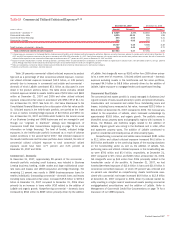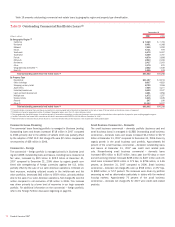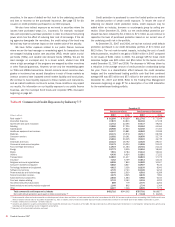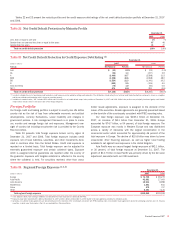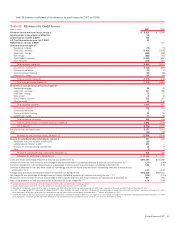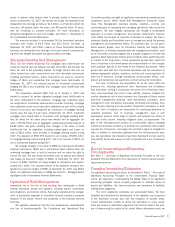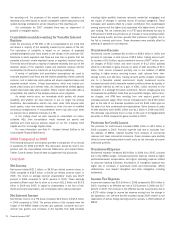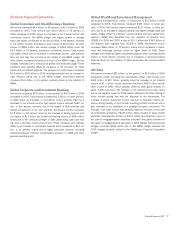Bank of America 2007 Annual Report Download - page 89
Download and view the complete annual report
Please find page 89 of the 2007 Bank of America annual report below. You can navigate through the pages in the report by either clicking on the pages listed below, or by using the keyword search tool below to find specific information within the annual report.rities and residential mortgage loans as part of the ALM portfolio. Fourth,
we create MSRs as part of our mortgage origination activities. See Note
1– Summary of Significant Accounting Principles and Note 21 – Mortgage
Servicing Rights to the Consolidated Financial Statements for additional
information on MSRs. Hedging instruments used to mitigate this risk
include options, futures, forwards, swaps, swaptions and securities.
Equity Market Risk
Equity market risk represents exposures to securities that represent an
ownership interest in a corporation in the form of domestic and foreign
common stock or other equity-linked instruments. Instruments that would
lead to this exposure include, but are not limited to, the following: com-
mon stock, exchange traded funds, American Depositary Receipts (ADRs),
convertible bonds, listed equity options (puts and calls), over-the-counter
equity options, equity total return swaps, equity index futures and other
equity derivative products. Hedging instruments used to mitigate this risk
include options, futures, swaps, convertible bonds and cash positions.
Commodity Risk
Commodity risk represents exposures to instruments traded in the petro-
leum, natural gas, power, and metals markets. These instruments consist
primarily of futures, forwards, swaps and options. Hedging instruments
used to mitigate this risk include options, futures and swaps in the same
or similar commodity product, as well as cash positions.
Issuer Credit Risk
Issuer credit risk represents exposures to changes in the creditworthiness
of individual issuers or groups of issuers. Our portfolio is exposed to
issuer credit risk where the value of an asset may be adversely impacted
by changes in the levels of credit spreads, by credit migration, or by
defaults. Hedging instruments used to mitigate this risk include bonds,
CDS and other credit fixed income instruments.
Market Liquidity Risk
Market liquidity risk represents the risk that expected market activity
changes dramatically and in certain cases may even cease to exist. This
exposes us to the risk that we will not be able to transact in an orderly
manner and may impact our results. This impact could further be
exacerbated if expected hedging or pricing correlations are impacted by
the disproportionate demand or lack of demand for certain instruments.
We utilize various risk mitigating techniques as discussed in more detail in
Trading Risk Management.
Trading Risk Management
Trading-related revenues represent the amount earned from trading posi-
tions, including market-based net interest income, which are taken in a
diverse range of financial instruments and markets. Trading account
assets and liabilities and derivative positions are reported at fair value.
For more information on fair value, see Note 19 – Fair Value Disclosures
to the Consolidated Financial Statements and Complex Accounting Esti-
mates beginning on page 93. Trading-related revenues can be volatile and
are largely driven by general market conditions and customer demand.
Trading-related revenues are dependent on the volume and type of trans-
actions, the level of risk assumed, and the volatility of price and rate
movements at any given time within the ever-changing market environ-
ment.
The GRC, chaired by the Global Markets Risk Executive, has been
designated by ALCO as the primary governance authority for Global Mar-
kets Risk Management including trading risk management. The GRC’s
focus is to take a forward-looking view of the primary credit and market
risks impacting CMAS and prioritize those that need a proactive risk miti-
gation strategy.
At the GRC meetings, the committee considers significant daily rev-
enues and losses by business along with an explanation of the primary
driver of the revenue or loss. Thresholds are established for each of our
businesses in order to determine if the revenue or loss is considered to be
significant for that business. If any of the thresholds are exceeded, an
explanation of the variance is made to the GRC. The thresholds are devel-
oped in coordination with the respective risk managers to highlight those
revenues or losses which exceed what is considered to be normal daily
income statement volatility.
Bank of America 2007
87


